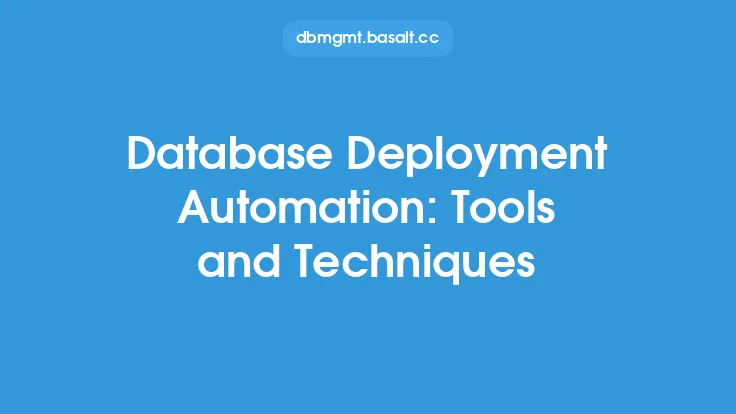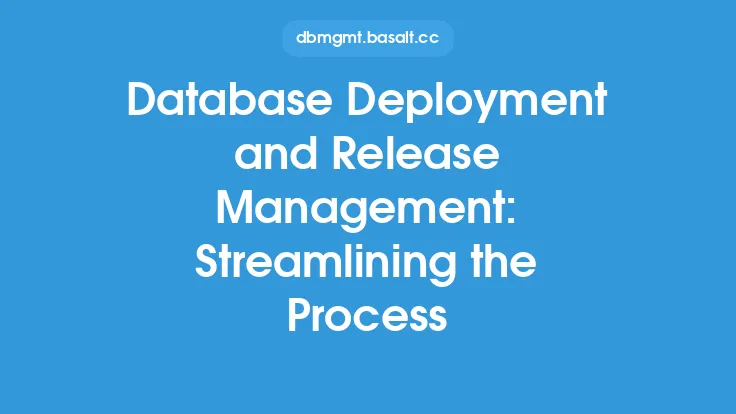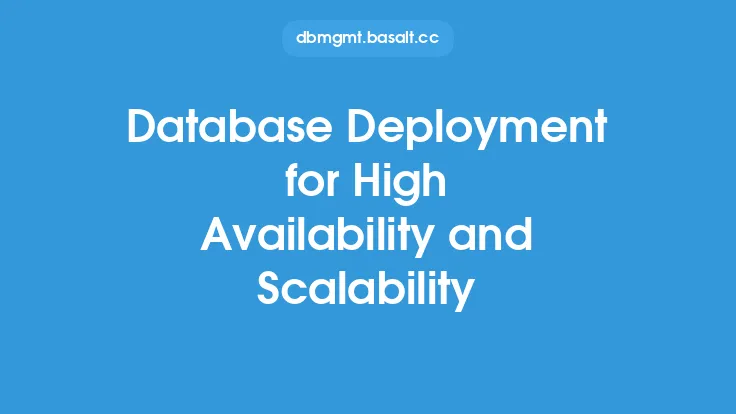Deploying a database is a complex process that involves several steps, from planning and design to execution and maintenance. Once a database is deployed, it is essential to monitor its performance and troubleshoot any issues that may arise. This is crucial to ensure the database is running smoothly, efficiently, and securely. In this article, we will delve into the world of database deployment monitoring and troubleshooting, exploring the various techniques, tools, and best practices used to identify and resolve issues.
Introduction to Database Deployment Monitoring
Database deployment monitoring is the process of tracking and analyzing the performance of a database after it has been deployed. This involves collecting and analyzing data on various aspects of the database, such as query execution time, memory usage, disk space, and network traffic. The goal of monitoring is to identify potential issues before they become critical, ensuring the database remains available, responsive, and secure. Monitoring also helps database administrators (DBAs) to optimize database performance, improve query execution, and reduce downtime.
Types of Database Deployment Monitoring
There are several types of monitoring that can be performed on a deployed database, including:
- Performance monitoring: This involves tracking the database's performance metrics, such as query execution time, CPU usage, memory usage, and disk space.
- Security monitoring: This involves tracking and analyzing security-related data, such as login attempts, access requests, and data modifications.
- Error monitoring: This involves tracking and analyzing error messages, such as syntax errors, connection errors, and query errors.
- Availability monitoring: This involves tracking the database's availability, including uptime, downtime, and response time.
Tools and Techniques for Database Deployment Monitoring
There are several tools and techniques available for monitoring a deployed database, including:
- Native monitoring tools: Most databases come with native monitoring tools, such as SQL Server Management Studio, Oracle Enterprise Manager, and MySQL Workbench.
- Third-party monitoring tools: There are several third-party monitoring tools available, such as Nagios, Prometheus, and Grafana.
- Scripting and automation: DBAs can use scripting languages, such as Python, PowerShell, and Bash, to automate monitoring tasks and create custom monitoring scripts.
- Cloud-based monitoring services: Cloud-based monitoring services, such as Amazon CloudWatch, Google Cloud Monitoring, and Microsoft Azure Monitor, provide a scalable and flexible way to monitor databases.
Database Deployment Troubleshooting
Troubleshooting is the process of identifying and resolving issues that arise during database deployment. This involves analyzing error messages, logs, and performance data to identify the root cause of the issue. Troubleshooting can be a complex and time-consuming process, requiring a deep understanding of the database, its configuration, and the underlying infrastructure.
Common Database Deployment Issues
Some common issues that may arise during database deployment include:
- Connection issues: Issues related to connecting to the database, such as authentication errors, network errors, and firewall issues.
- Query performance issues: Issues related to query execution, such as slow query performance, deadlocks, and resource contention.
- Data integrity issues: Issues related to data consistency and accuracy, such as data corruption, inconsistencies, and anomalies.
- Security issues: Issues related to database security, such as unauthorized access, data breaches, and vulnerabilities.
Best Practices for Database Deployment Monitoring and Troubleshooting
To ensure effective monitoring and troubleshooting, DBAs should follow best practices, such as:
- Implementing a monitoring strategy: Develop a comprehensive monitoring strategy that includes performance, security, error, and availability monitoring.
- Using automation: Automate monitoring tasks and troubleshooting processes to reduce downtime and improve response time.
- Analyzing logs and error messages: Regularly analyze logs and error messages to identify potential issues and troubleshoot problems.
- Testing and validation: Test and validate database changes and updates to ensure they do not introduce new issues or exacerbate existing ones.
- Collaboration and communication: Collaborate with other teams, such as development and operations, to ensure effective communication and issue resolution.
Conclusion
Database deployment monitoring and troubleshooting are critical components of database administration. By implementing a comprehensive monitoring strategy, using automation and scripting, and following best practices, DBAs can ensure their databases are running smoothly, efficiently, and securely. Effective monitoring and troubleshooting can help reduce downtime, improve performance, and increase overall database reliability. As databases continue to play a critical role in modern applications, the importance of monitoring and troubleshooting will only continue to grow.





